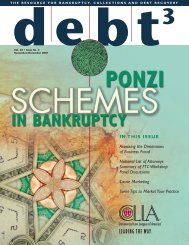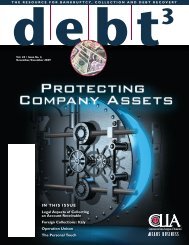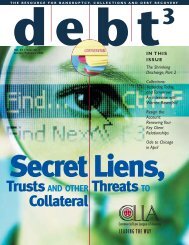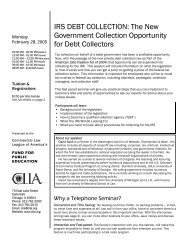leading the way - Commercial Law League Of America
leading the way - Commercial Law League Of America
leading the way - Commercial Law League Of America
Create successful ePaper yourself
Turn your PDF publications into a flip-book with our unique Google optimized e-Paper software.
leadership<br />
The research group I worked on at <strong>the</strong> University of<br />
Chicago included a heart surgeon, an endocrinologist, two<br />
Ph.D’s in educational research, a psychologist, a couple of<br />
nurse practitioners and me—a marketing writer. It was <strong>the</strong><br />
idea of my boss, Dr. Wylie McNabb, to add a marketer to<br />
<strong>the</strong> group. He had heard <strong>the</strong> old adage that a good salesman<br />
could “sell ice cubes to Eskimos,” and wanted to see if<br />
it was true. My first assignment was to look at <strong>the</strong> educational<br />
materials and classes that had been developed from<br />
an advertiser’s perspective. He asked me to consider marketing<br />
techniques that would get patients to “buy” in.<br />
At first, I felt like I was in over my head. The information<br />
was clear and so were <strong>the</strong> consequences. But as I spoke<br />
with patients, I began to hear <strong>the</strong> same things again and<br />
again. “What’s <strong>the</strong> use?” “I have lived this <strong>way</strong> for so many<br />
years, I can’t change now.” “But I love cigarettes … or<br />
booze … or fried food … etc.” “I can’t change because my<br />
partner … family … friends … or co-workers, etc. live this<br />
<strong>way</strong> too.”<br />
Patients weren’t motivated to change because <strong>the</strong>y believed<br />
that <strong>the</strong>y couldn’t. And, I believed that <strong>the</strong>re was ano<strong>the</strong>r<br />
problem under <strong>the</strong> surface—<strong>the</strong>y weren’t being given positive<br />
choices. They were given information, ultimatums, and<br />
substitutions.<br />
An advertiser would go out of business trying to sell this<br />
<strong>way</strong>! Just imagine <strong>the</strong> slogans—“Drink Diet Coke, it won’t<br />
make you as fat as regular Coke!” “Drive a Volvo, so that<br />
you won’t die in a crash!” “Come to Disney World. It’s not<br />
as boring as your normal life.” It occurred to me that people<br />
need a strong, positive offer and easy instructions on<br />
how to receive <strong>the</strong> offer.<br />
As we began to structure our educational programs as a<br />
positive marketing offer, <strong>the</strong> results began to change. For<br />
example, in a class for children under 12 years old with<br />
type-one diabetes, we taught <strong>the</strong>m to give <strong>the</strong>mselves an<br />
insulin shot twice a day by becoming “Sugar Busters.” Like<br />
<strong>the</strong> Ghost Busters (popular at <strong>the</strong> time) <strong>the</strong>y were given a<br />
“weapon” to fight monsters—Hypo and Hyper<br />
(glycemia)—<strong>the</strong>ir syringe. We created a comic book for <strong>the</strong><br />
program that showed heroic children <strong>the</strong>ir age using riflesized<br />
syringes to defend <strong>the</strong>mselves against <strong>the</strong> bad guys.<br />
When a child gave him or herself <strong>the</strong>ir first shot without<br />
help from a nurse or parent, <strong>the</strong>y received an official Sugar-<br />
Buster Badge and a wall plaque. The program transformed<br />
children who screamed and cried every time <strong>the</strong>y saw <strong>the</strong><br />
needle, into kids who couldn’t wait to give <strong>the</strong>mselves <strong>the</strong><br />
first shot. The positive choices empowered <strong>the</strong>m and minimized<br />
<strong>the</strong> threat.<br />
In a program to help adult diabetics lower <strong>the</strong>ir fat and<br />
sugar intake, we created a lunchtime cooking club. The<br />
combination of free food and natural competition among<br />
cooks who brought dishes and shared recipes, made <strong>the</strong><br />
lunchtime meetings very popular. Inexpensive free offers<br />
like food scales and measuring cups drew new members to<br />
<strong>the</strong> meetings. We moderated <strong>the</strong> fun, but didn’t have to do<br />
very much teaching because <strong>the</strong> attendees were learning to<br />
make positive choices from each o<strong>the</strong>r and meeting new<br />
friends, too.<br />
The early results measuring compliance and health outcomes<br />
were some of <strong>the</strong> best results ever found in medical<br />
education research. Unfortunately, that winter Congress<br />
passed an emergency tax reduction bill that cut all National<br />
Institutes of Health Research Grants by one third across <strong>the</strong><br />
board. The research stalled, I was out of a job.<br />
While that was more than 15 years ago, I have never forgotten<br />
what we learned about human motivation in that study.<br />
And I believe it is applicable to many situations, especially<br />
<strong>the</strong> workplace.<br />
I still don’t know why people won’t do what <strong>the</strong>y’re told.<br />
But I do know how to “make <strong>the</strong>m an offer that <strong>the</strong>y can’t<br />
refuse.” Information, ultimatums, and substitutions don’t<br />
work nearly as well as a strong positive offer that empowers<br />
people and minimizes <strong>the</strong> threat.<br />
Creating <strong>the</strong> <strong>Of</strong>fer<br />
Employees who expect a clear reward, such as a promotion<br />
or monetary bonus, for <strong>the</strong> timely, successful completion of<br />
a goal will be inclined to work harder and give it <strong>the</strong>ir best,<br />
especially if <strong>the</strong> goal is clear and <strong>the</strong> expectation of attainment<br />
is high. While it may seem to a manager that an offer<br />
is hard to refuse, individuals will assess five factors before<br />
deciding on <strong>the</strong>ir course of action. These are:<br />
• If I attempt this behavior, am I likely to succeed?<br />
• How much do I value <strong>the</strong> offer?<br />
• Is <strong>the</strong> new behavior intrinsically valuable?<br />
(For example, will I be liked by my co-workers and<br />
respected by management.)<br />
• Does this value outweigh any negative consequences?<br />
(Will co-workers reject me for “sucking up to<br />
<strong>the</strong> boss?”)<br />
• Will my new behavior be acceptable to my family?<br />
(Or, will overtime cut into family time.)<br />
Managers who create motivational offers must <strong>the</strong>refore<br />
find desirable, valued outcomes that outweigh <strong>the</strong> natural<br />
desire to keep things <strong>the</strong> <strong>way</strong> <strong>the</strong>y are. And, ra<strong>the</strong>r than<br />
simply assuming <strong>the</strong>y know what <strong>the</strong>ir employees really<br />
want, <strong>the</strong>y should interview <strong>the</strong>m and candidly ask what<br />
kind of incentives would be most desirable. Surprisingly, it’s<br />
not al<strong>way</strong>s about money. Choices that take into account a<br />
variety of employee preferences will be more desirable than<br />
single options.<br />
(continued on page 28)<br />
“…make <strong>the</strong>m<br />
an offer that <strong>the</strong>y<br />
can’t refuse.”<br />
Information,<br />
ultimatums,<br />
and substitutions<br />
don’t work nearly<br />
as well as a<br />
strong positive<br />
offer that<br />
empowers people<br />
and minimizes<br />
<strong>the</strong> threat.<br />
Debt 3 March/April 2007<br />
27















